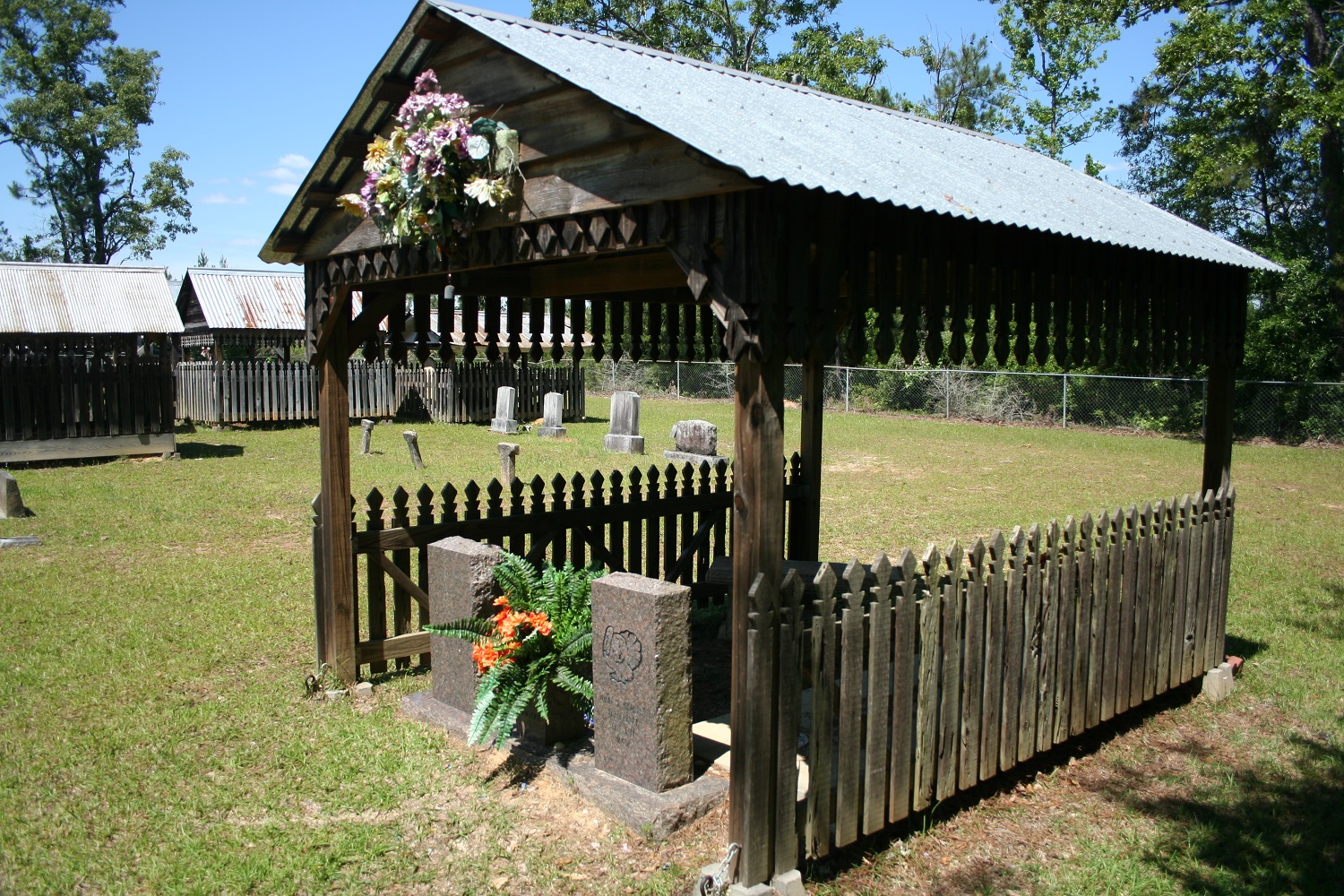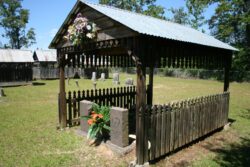“Don’t Let the Rain Fall on My Face”
The wooden grave houses of Talbert-Pierson Cemetery
Published: November 29, 2022
Last Updated: June 1, 2023

Photo by Keagan LeJeune
The road I ended up on was one you go alone. Talbert Cemetery Road, off Highway 112 near Sugartown, is a country road, the narrow, one-car-wide kind. The kind of road with a long grave-deep ditch running aside it, the kind of road that if I see a set of headlights up ahead, I shimmy to the shoulder and suck in my gut so we can both squeeze by.
The surface of it isn’t gravel, but a bone-pale asphalt that’s flaking away. Its shoulder of clay is as red as an open wound. The telephone poles running alongside seem like alien crosses and the scrub pine growing on the other side of the ditch can convince a body the world’s closing in. In other words, Talbert Cemetery Road is the kind of road I like. It’s a good-for-getting-lost kind of road.
The Talbert-Pierson Cemetery was placed on the National Register of Historic Places in 2003. It’s noted for the remarkable house-like structures built above the graves and especially for the number of these small, curious buildings a visitor can find there. If you ask about the origins of these structures, about the history behind this tradition, you’ll hear debate. Different scholars have pointed to various sources for the gravehouses—European, African, American Indian, French, Catholic, Protestant, British, Redbone.
What do you call these house-like structures? That’s its own sort of mystery too.
Gravehouses, graveshelters, a grave shed, a shelter house, board mausoleums, spirit houses, les petites maisons in Louisiana French cemeteries, lattice huts, grave boxes—all these monikers have been used.
In Talbert-Pierson Cemetery, the tiny structures are positioned in what amounts to three rows, each running near the rear of the cemetery. The first row contains seven wooden shelters, the second has six, and the last row contains only two. A few other gravehouses have been added over the years, but these first fifteen are the most historic. The oldest dates from 1889. It’s for James Talbert Sr., the patriarch. The gravehouse is surrounded by walls made of fence pickets, each with a diamond shape at its top.
Over the years, people have made some slight alterations to keep the structures standing, but the gravehouses retain an incredible degree of their original materials. The walls are mostly French Gothic fence pickets attached to wooden sills that run along the ground. The roof is often metal, a sheet of tin. The gable end is sealed with clapboard siding. From it hangs ornamental edgework or even the pickets themselves, turned upside-down and dangling like ornate Victorian eaves. Covering the grave itself—a layer of shells, pebbles, and crushed stone.
Why were they built? That’s another mystery.
An old legend tells the fate of a homesteading family. Once, long ago, a man lived the hard-scrabble life of a pioneer. He married a woman as independent as he was; she had to be. The couple had a fierce and prideful bunch of sons and daughters. Finally, the tough old man faced death; his people gathered round.
Gravely ill, coughing on his deathbed, the father spoke as best he could. “My children,” he said, “my time is short. When I go, bury me in that corner of the pasture with the big oak trees. And don’t let the rain fall on my face.”
His children followed his wishes. They built a pine box to hold his body, dug a hole in his favorite corner of the farm, and to keep the rain from falling on his face, cut and nailed and stuck boards together to build a small house to cover his grave.
The afternoon I walked Talbert-Pierson was a few months after Hurricane Laura, and I went there to check on things. I have no ties to the place other than I know its importance, no reason other than something you can call curiosity or concern. That day, a felled pine tree crushed the benches outside the small white Pine Grove church building. There was another huge trunk lying prone against the cemetery’s fenceline. Some of the pickets had been ripped away. A gable was falling in. Inside the houses, snatches of poorman pepperweed were growing on top of the graves. Torn-away pieces of roofing carpeted parts of the small stepping-stone path strung between two rows of the cemetery’s spirit houses. Then and now I wonder if places like this will survive the storms. Will we remember them when we rebuild? Will we go the extra mile in restoring what makes them historic? It’s an anticipation that’s built of anxiety—or the other way around.
You can read the whole story of the homesteading family and an excellent history of Talbert Cemetery and gravehouses in Marcy Frantom’s “In My Father’s House: North Louisiana Gravehouses as Art and Technology,” found online in the Louisiana Folklife Program’s internet archives.
Keagan LeJeune teaches English and folklore at McNeese State University. He is the former President of the Louisiana Folklore Society and the former editor of that society’s journal, Louisiana Folklore Miscellany. Always for the Underdog: Leather Britches Smith and the Grabow War was published by the University of North Texas Press in conjunction with the Texas Folklore Society. Legendary Louisiana Outlaws, which won the 2016 Brian McConnell Book Award and the 2017 Louisiana Literary Award, was published by Louisiana State University Press.
